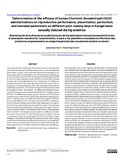Determination of the efficacy of human Chorionic Gonadotropin (hCG) administrations on reproductive performance, placentation, parturition, and neonatal parameters on different post–mating days in Kangal ewes sexually induced during anestrus

View/
Date
2023Palabras Clave
Anestro, Apareamientos, Kangal, Ovejas, Progesterona, ReproducciónAnestrus, Postmating, Kangal, Sheep, Progesterone, Reproduction
Metadata
Show full item recordAbstract
This study aimed to determine the efficacy of post mating human
Chorionic Gonadotropin (hCG) during anestrus on the formation of
the accessory corpus luteum and some reproductive parameters. For
this purpose. after synchronization of all the animal were divided into
group 1 (n=100), group 2 (n=100), and group 3 (n=100) by applying 600
IU of hCG 6 d after sponge removal, 600 IU of hCG 8 d after sponge
removal, and no hCG application (Control), respectively. The difference
between groups in terms of reproductive parameters such as estrus,
pregnancy, multiple pregnancy, litter size, and productivity was not
statistically significant. The live birth weight of lambs was evaluated
for singletons, twins, and triplets. The difference between group 1
and the control group was statistically significant in singleton lambs
(P=0.04). The difference between group 1 and control (P<0.001) and
between group 2 and control (P<0.001) was statistically significant for
twins. In triplets, group 1 was different from both groups (P<0.001) and
group 2 was different from the control group (P<0.001). In addition,
when the placenta weight and the daily body weight gain of singleton
lamb in the neonatal stage were examined, the values of both groups
that were administered with post mating hCG were higher than the
control group (P<0.001). The Progesterone (P4) level in blood samples
taken on the 21st d of pregnancy was found to be different between
all groups. Furthermore, P4 levels were found to be higher in group
1 compared to the other two groups (P<0.001). In the light of these
findings, it was determined that hCG administration after mating
contributed to placenta and offspring development by elevating P4
levels. It was concluded that hCG should be administered 6 d after
the sponge will be removed (on d 5 postmating) for optimal efficacy.
Collections
Información Adicional
| Otros Títulos | Determinación de la eficacia de la administración de Gonadotropina Corionica humana (hCG) sobre el desempeño reproductivo, la placentación, el parto y los parámetros neonatales en diferentes días posteriores al apareamiento en ovejas Kangal inducidas sexualmente durante el anestro |
| Correo Electrónico | abdurrahmantakci@cumhuriyet.edu.tr |
| Editor | SaberULA |
| ISSN | 0798-2259 |
| ISSN Electrónico | 2477-944X |
| Resumen en otro Idioma | Este estudio tuvo como objetivo determinar la eficacia de los tratamientos con gonadotropina coriónica humana (hCG) posemparejamiento durante el anestro sobre la formación del cuerpo lúteo accesorio y algunos parámetros reproductivos. Para ello, después de la sincronización de todos los animales se dividieron en grupo 1 (n=100), grupo 2 (n=100) y grupo 3 (n=100) mediante la aplicación de 600 UI de hCG 6 d después de la eliminación de la esponja, 600 UI de hCG 8 d después de retirar la esponja y sin aplicación de hCG (Control), respectivamente. La diferencia entre grupos en términos de parámetros reproductivos como celo, preñez, preñez múltiple, tamaño de la camada y productividad no fue estadísticamente significativa. Se evaluó el peso vivo al nacer de los corderos para los únicos, mellizos y trillizos. La diferencia entre el grupo 1 y el grupo control fue estadísticamente significativa en los corderos únicos (P=0,04). La diferencia entre el grupo 1 y el control (P<0,001) y entre el grupo 2 y el control (P<0,001) fue estadísticamente significativa para los gemelos. En los trillizos, el grupo 1 fue diferente de ambos grupos (P<0,001) y el grupo 2 fue diferente del grupo control (P<0,001). Además, cuando se examinaron el peso de la placenta y la ganancia diaria de peso corporal de corderos únicos en la etapa neonatal, los valores de ambos grupos que recibieron hCG posemparejamiento fueron más altos que el grupo control (P<0.001). Se encontró que el nivel de progesterona (P4) en las muestras de sangre tomadas el d 21 the preñez era diferente entre todos los grupos. Además, se encontró que los niveles de P4 eran más altos en el grupo 1 en comparación con los otros dos grupos (P<0,001). A la luz de estos hallazgos, se determinó que la administración de hCG después del apareamiento contribuía al desarrollo de la placenta y la descendencia al elevar los niveles de progesterona. Se concluyó que la hCG debe administrarse 6 d después de retirar la esponja (el d 5 después del apareamiento) para una eficacia óptima. |
| Colación | 1-7 |
| País | Venezuela |
| Institución | Universidad del Zulia (LUZ) Universidad de Los Andes (ULA) |
| Publicación Electrónica | Revista Científica |
| Sección | Revista Científica: Artículos |





